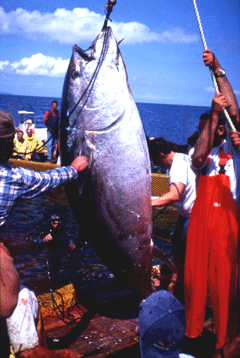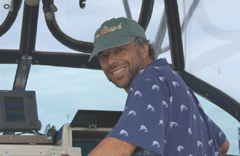Tuna In Trouble
Air Date: Week of January 26, 2007

A large bluefin tuna gets caught up off the coast of Stintino, Sardinia, Italy. (Courtesy of National Oceanic and Atmospheric Administration/Department of Commerce)
Host Steve Curwood talks with Dr. Carl Safina, head of the Blue Ocean Institute, about the state of the bluefin tuna. Spawning stocks of bluefin are reportedly down 90 percent, and scientists say the bluefin may be heading toward commercial extinction. Fishing management groups from around the world recently met in Japan to come up with a plan to protect the fish.
Transcript
CURWOOD: It’s Living on Earth, I’m Steve Curwood. Not so long ago the giant bluefin tuna—the most desired fish for sushi and sashimi posted record prices. At one point in 2005 a single bluefin went for more than $170,000 at a Japanese market. Now it seems that these fish may soon not be available at any price.
Scientists say that at the present rate of decline the bluefin are headed for commercial extinction. But now, for the first time ever, the various regional bodies that regulate tuna fishing have come up with a worldwide plan to rebuild the bluefin and other tuna stocks to sustainable levels.
The plan, which was developed at a recent meeting in Japan, includes a crackdown on illegal fishing and gathering more data on fish stocks. But some conservationist say this plan doesn’t go far enough. Carl Safina is the president of the Blue Ocean Institute and the author of more than a 100 scientific and popular publications about ecology and the oceans. He’s on the line with us from New York. Carl, first of all, tell us about the bluefin tuna.
SAFINA: Ah, the blue fin is really just about the mightiest fish in the sea that exists at potentially high population levels in big big schools. There’s nothing on land that is a predator that could live at those kinds of numbers and densities as the original populations of tunas. So, they were like these big thundering herds of predators in the ocean. And they, they eat mostly smaller fish like anchovies and mackerel and they also eat squid, things like that. And they were thrilling to see, chasing fish at the surface at 50 miles per hour and shredding the surface white in big schools, vaulting into the air, crashing down with big explosions. They really were just one of the most thrilling sights in the entire ocean.

A large bluefin tuna gets caught up off the coast of Stintino, Sardinia, Italy. (Courtesy of National Oceanic and Atmospheric Administration/Department of Commerce)
SAFINA: They have crashed. And they’re continuing to decline to very low levels. That is why in the 1990s, when they were declining, we were on a campaign to try to cut the fishing quota by half, because every year fisherman caught the entire quota. The population models said they would continue to decline unless the quota was cut in half. If the quota was cut in half they would start to level out and then slowly increase. Everybody said they couldn’t live with a quota that was cut in half. So what they have now is a quota that’s the same but their catches are only down to somewhere between 10 and 13 percent of the quota. So they resisted having the quota and recovering the fish and now what they have is a 90 percent reduction in catch.
CURWOOD: Now what does all this mean for us consumers? Um. the bluefin tuna are in dire trouble you say. But what about the other tunas, the skip jack and the albacore, the stuff that you more typically find in a can? Where’s that headed?
SAFINA: That’s headed to a very depleted place but right now it’s not there. The bluefin tuna is there. The bluefin tuna is very depleted. It’s extremely expensive. They’re very hard to find. Almost nobody can enjoy them on any level. They’re pretty much missing from their role as ocean predators. The other tuna have declined a lot in most places and if we leave this situation the way it is without fixing it we will start to really have shortages of these kinds of things and they will be missing from the choices that we have as far as what we can eat. And as the fish decline we’ll likely see the prices go up. Right now canned tuna is very affordable. That may become more of a luxury item or the supply may shift more into the luxury market and be less available and less affordable.

Dr. Carl Safina (Courtesy of Blue Ocean Institute)
SAFINA: Yeah, don’t do that, ok?
CURWOOD: (laughing) Ok. Now among the fishing nations which are the worst offenders?
SAFINA: The worst offenders are Japan, and northern Europe are the worst. Northern Europe are exporting a lot of over-fishing to poor parts of the world like Africa and the Indian Ocean. And Japan has not only been a gigantic market that just sucks up fish from all the world’s oceans, but they’ve really bullied lots of countries and threatened them economically to keep fishing quotas high and to resist conservation initiatives.
CURWOOD: What’s the significance of this meeting of all the regional fisheries management agencies that are concerned with tuna coming together in Kobe, ah Japan to talk about this?
SAFINA: It could mean one of two things to me. It means either that they’re starting to get beyond denial and they’re starting to realize that the viability of the fisheries is really now in question. And they’re admitting that to themselves. Or they’re maneuvering to show that they’re doing something, that they’re talking about the problem and that therefore other ways of dealing with it, like listing the species on the endangered species list, or listing it internationally under the convention on international trade and endangered species, do not need to be invoked. It may be a way of just saying, “we’re handling it, stay away from us.” They’re staging theater and going through a charade.
CURWOOD: That’s a pretty cynical view.
SAFINA: I don’t think it’s cynical. I think it would be wishful thinking if I said that I think they are resolved to do the right thing because they never have done the right thing despite a lot of attention and a lot of criticism that has come their way.
CURWOOD: Carl Safina is the president of the Blue Ocean Institute and the author of Song for the Blue Ocean and Voyage of the Turtle. Thank you sir.
SAFINA: Thank you very much, always a pleasure.
Links
WWF: Tuna stocks sink- manage it right or lose it!
International Commission for the Conservation of Atlantic Tunas
Living on Earth wants to hear from you!
Living on Earth
62 Calef Highway, Suite 212
Lee, NH 03861
Telephone: 617-287-4121
E-mail: comments@loe.org
Newsletter [Click here]
Donate to Living on Earth!
Living on Earth is an independent media program and relies entirely on contributions from listeners and institutions supporting public service. Please donate now to preserve an independent environmental voice.
NewsletterLiving on Earth offers a weekly delivery of the show's rundown to your mailbox. Sign up for our newsletter today!
 Sailors For The Sea: Be the change you want to sea.
Sailors For The Sea: Be the change you want to sea.
 The Grantham Foundation for the Protection of the Environment: Committed to protecting and improving the health of the global environment.
The Grantham Foundation for the Protection of the Environment: Committed to protecting and improving the health of the global environment.
 Contribute to Living on Earth and receive, as our gift to you, an archival print of one of Mark Seth Lender's extraordinary wildlife photographs. Follow the link to see Mark's current collection of photographs.
Contribute to Living on Earth and receive, as our gift to you, an archival print of one of Mark Seth Lender's extraordinary wildlife photographs. Follow the link to see Mark's current collection of photographs.
 Buy a signed copy of Mark Seth Lender's book Smeagull the Seagull & support Living on Earth
Buy a signed copy of Mark Seth Lender's book Smeagull the Seagull & support Living on Earth

